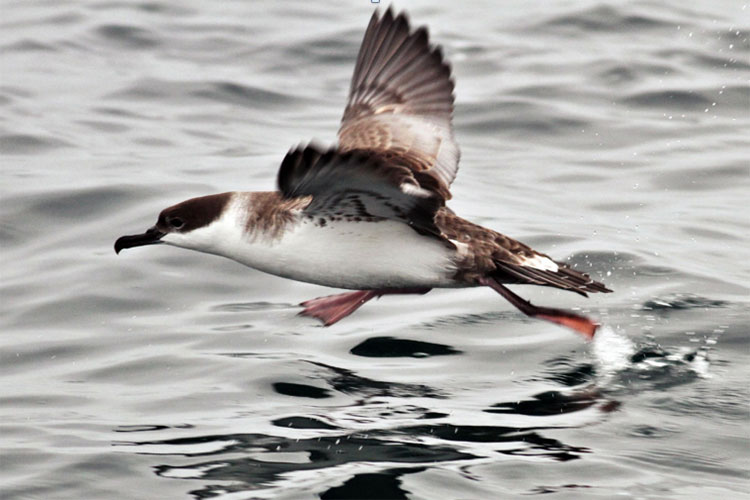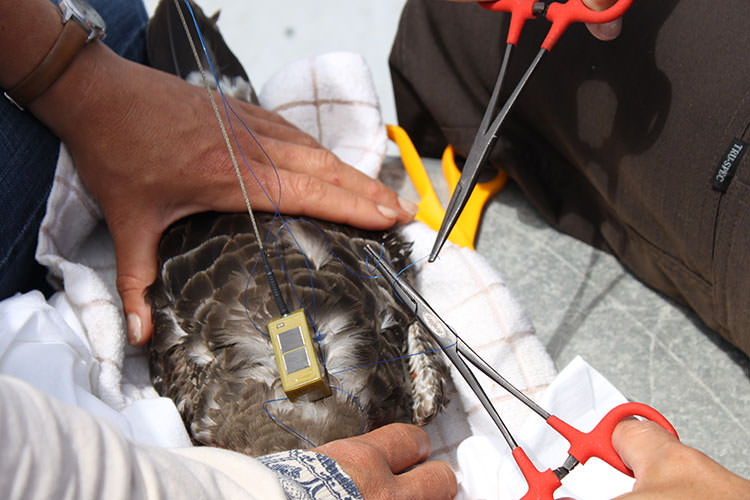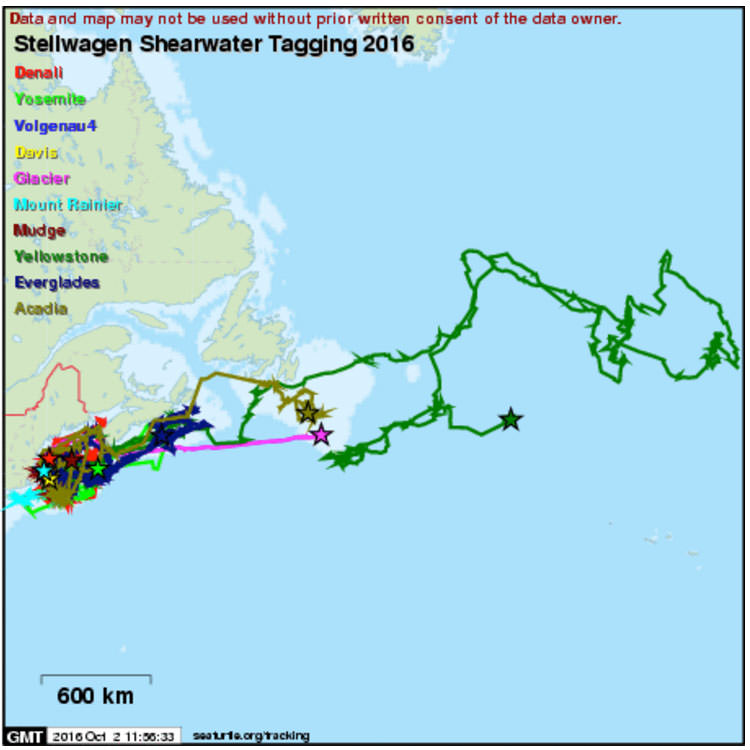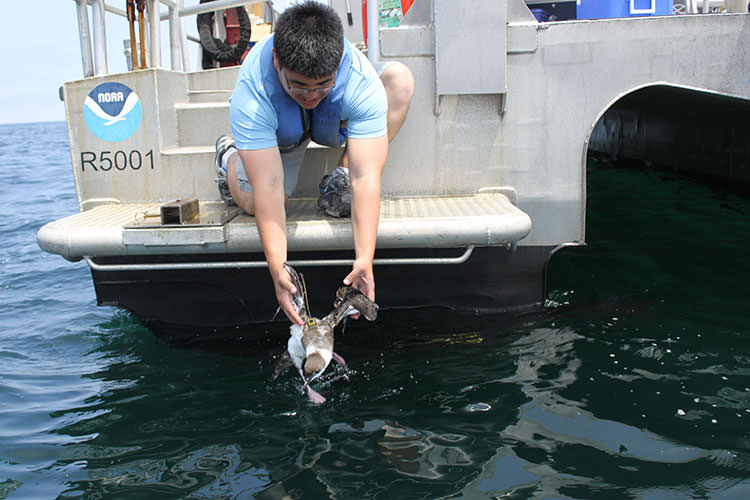Birds as Indicators of Ecosystem Health
by Jessica Blakely and Casey Brayton
November 2016
How can you tell where a tiny forage fish like the sand lance spends its days? Look at what’s eating it.
Popular recreational and commercial fishing species such as Atlantic cod, halibut, flounder and monkfish rely on sand lance as a staple of their diets. These forage fish are also on the menus for predators like humpback whales and many kinds of seabirds, including the great shearwater. However, sand lance are moderately vulnerable to changes in ocean and climate patterns, especially warming seas and ocean acidification. "The numbers of these forage fish (sand lance) fluctuate and have been relatively low in the past few years," explains David Wiley, research coordinator for Stellwagen Bank National Marine Sanctuary. Over the past several years, sanctuary scientists have been studying great shearwater populations to better understand the availability of food like the sand lance throughout the sanctuary.
Great shearwaters, one of the many seabird species found within Stellwagen Bank National Marine Sanctuary, forage for fish by plunging underwater from the air or by seizing items while swimming on the surface. The birds rely on the sand lance, or "sand eels," as major food source in the sanctuary and other parts of the North Atlantic. Populations of these fish depend on oceanographic conditions such as water temperature, current path and nutrient availability; however, these conditions will likely be altered as the marine environment changes. For instance, as the ocean surface warms, changes in upwelling currents could cause fewer nutrients from deeper ocean waters to be brought to the surface, which limits the level of primary productivity of phytoplankton. If there's less primary productivity, there will be less prey for sand lance, which also means fewer sand lance for shearwaters to forage.

In April these seabirds begin their migration up the eastern Atlantic seaboard to forage in the Gulf of Maine. When leaving in the late summer or fall, they migrate in a “figure 8” route, heading east across the Atlantic, south to the North African coast, west across the equator to the South America’s Patagonia Shelf, and then on to Nightingale Island, Inaccessible Island, Tristan da Cunha, and Gough Island in the South Atlantic, where mature animals breed. Their food of choice, the sand lance, thrives in the sandy terrain under the waters of Stellwagen Bank, but rising ocean temperatures and climate-induced changes to prevailing wind patterns could impede the travels of these birds, putting the productive waters of the sanctuary and other parts of the North Atlantic out of reach. In addition, increasingly acidic oceans could reduce productivity and abundance of these forage fish, causing the great shearwaters to alter their movements according to where prey remains in higher numbers.
This summer, researchers in Stellwagen Bank National Marine Sanctuary launched their fourth cruise since 2013 to document this well-known predator of sand lance in an ongoing study of the birds’ flight paths and foraging and feeding habits. Each year, scientists aboard the sanctuary research vessel Auk use satellite tags to monitor movements of ten great shearwaters, following them through the sanctuary and beyond. In addition to the satellite tagging, this summer breath, feather and blood samples were taken from the great shearwaters to determine what they had eaten in the past days, weeks and months, respectively. The team also took samples from two sooty shearwaters and one manx shearwater, the first time these species were included in the project.

Researchers have coupled the data on the birds’ movements with existing oceanographic data, such as water temperature, chlorophyll concentration and other factors that might result in increased productivity or prey concentrations. The birds can be seriously affected by alterations in their food supply, which are often dictated by water temperature, currents or other factors.
Because the birds are more easily visible than species like sand lance, they are excellent indicators of ecosystem health, and can even mark changes that may occur due to climate change, Wiley says. By mapping the migration of the predatory shearwaters year after year, as Stellwagen Bank has, we can see these changes in real time, and can learn more about the abundance of prey species supporting the rest of the Stellwagen Bank National Marine Sanctuary ecosystem.

From July to November, the research shows that these great shearwaters traveled an average 515 kilometers per week and spent the majority of their time foraging around the rim of the Gulf of Maine where waters are less than 100 meters deep. Researchers also found that, rather than keying in on a single oceanographic factor, the shearwaters used a more flexible foraging strategy. This could mean that shearwaters are adapted to local environmental variability, making them more resilient to climate change, if potential wind shifts do not preclude their journey to the North Atlantic.
Shearwaters are not shy about approaching boats or people, often curiously probing and snatching fish right off the deck of commercial and recreational fishing boats. Unfortunately, their bold spirit can be troublesome; shearwaters can be accidently trapped as bycatch in fishing nets if they dive underwater to snatch food. For this reason, mapping where shearwaters feed within the sanctuary will also identify areas of high bycatch potential to help sanctuary managers make preventive plans to reduce bycatch.

Looking Forward: Soaring shearwaters travel nearly 20,000 miles a year to use Stellwagen Bank National Marine Sanctuary, an international Important Bird Area, as their feeding ground. Another 52 seabird species are also supported by sanctuary waters. In return, these animals contribute to the overall sanctuary ecosystem and are essential barometers of change in the environment.
Stellwagen Bank National Marine Sanctuary needs our collective help to protect the seabirds’ ocean habitat for the animals and for us. One of the largest threats to birds and other ocean animals is rising sea surface temperature due to climate change. When we burn fossil fuels, like oil, coal and natural gas for energy, we are adding carbon dioxide into the atmosphere where it acts like a heat trapping blanket, warming Earth, including the ocean. A warmer ocean may change ocean circulation patterns that bring food to the surface and cause prey species such as sand lance to shift home ranges. If this occurs, the sanctuary may no longer be able to support the community of animals that we have come to know and love.
We can help lessen the threats now by burning fewer fossil fuels. Communities have developed a number of creative programs, including bike shares, farmers markets, energy audits and alternative energy incentives. Join or work with your community to start a program and help protect our magnificent ocean for the animals, for us, and for our future.
The research is led by Stellwagen Bank National Marine Sanctuar's Dr. David Wiley, research coordinator; Michael Thompson, geographer; and Brad Cabe, GIS specialist. It is conducted in collaboration with Linda Welch, US Fish and Wildlife Service; seabird specialists at the Maine Coastal Islands National Wildlife Refuge; Andrew Allyn, Ph.D candidate at the University of Massachusetts in Amherst; Dr. Robert Ronconi, Postdoctoral Researcher, Dept. of Biology, Acadia University; Dr. Les Kaufman, Dept. of Biology Boston University; Dr. Kent Hatch, Long Island University; and Kevin Powers of Stellwagen Bank National Marine Sanctuary. The 2016 project is funded thanks to the Volgenau Foundation.
For more information, click here, or contact David.Wiley@noaa.gov.

